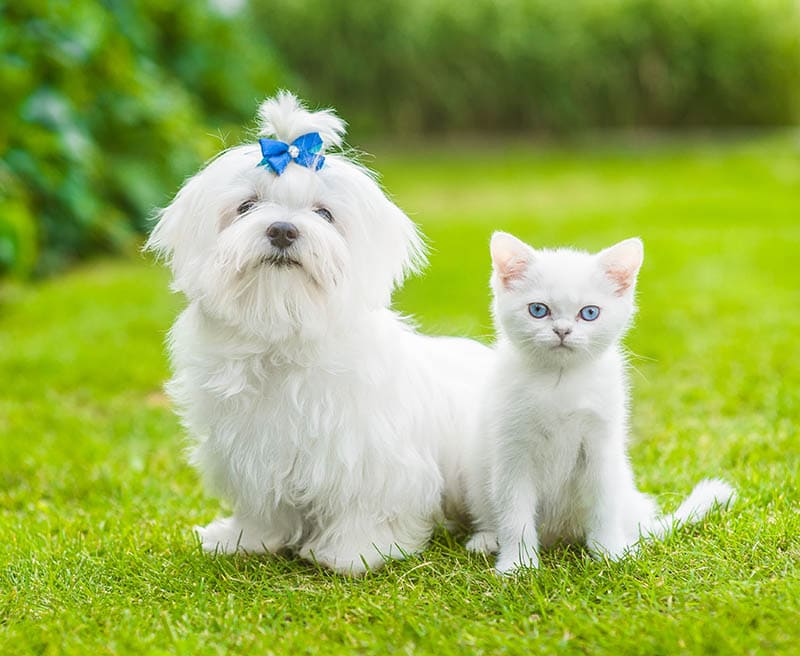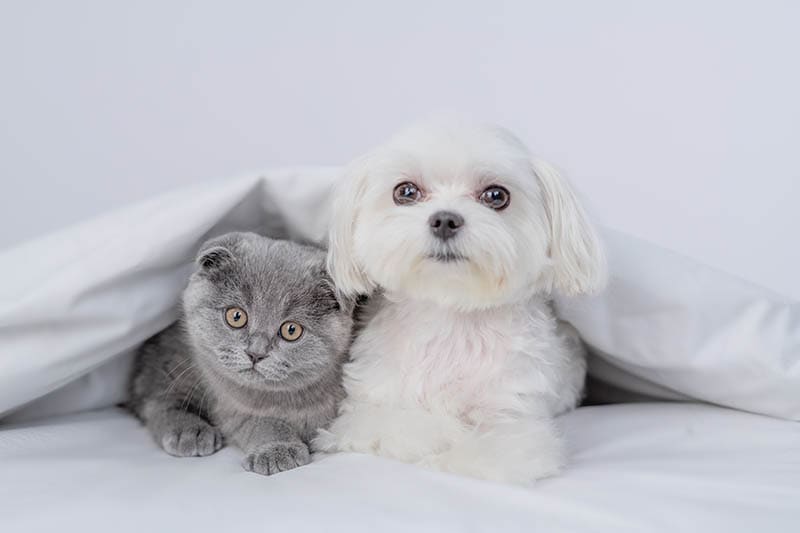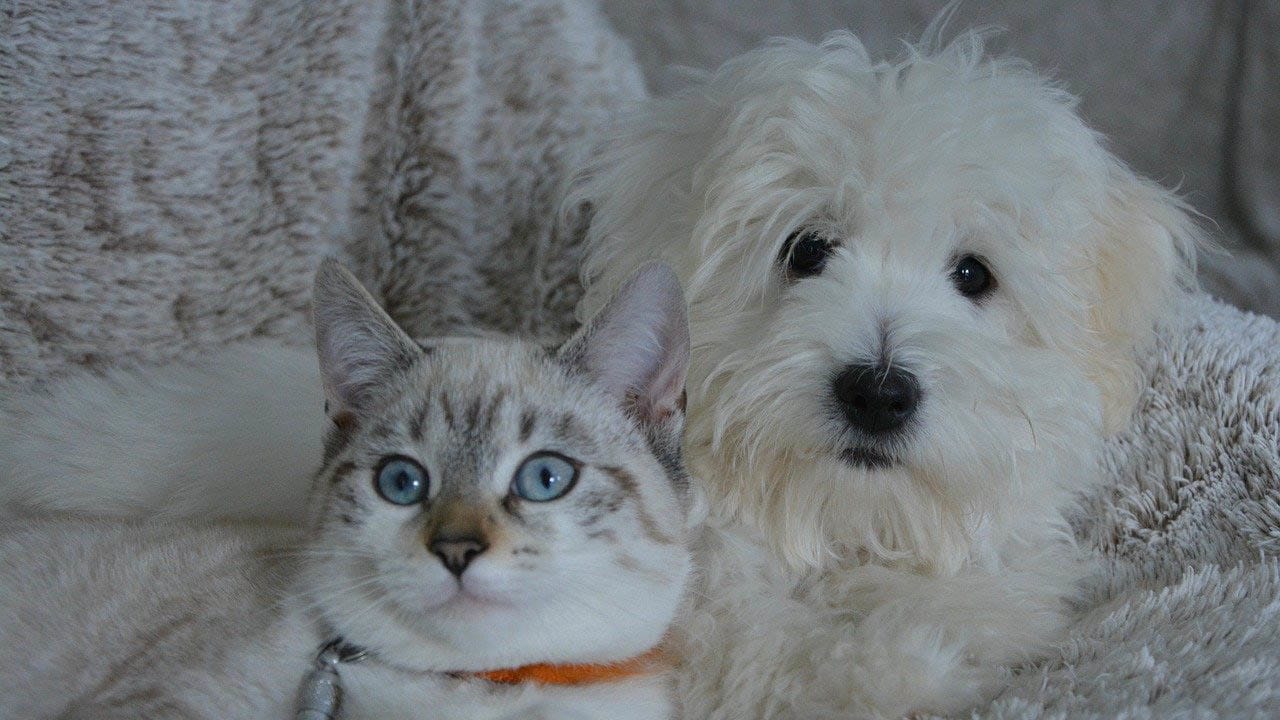Are Maltese dogs good with cats? Many pet owners ponder over this question when considering adding a Maltese to their family that already includes a feline friend. Known for their charming personality and luxurious white coat, Maltese dogs are certainly a popular choice. But how well do they get along with cats?

When it comes to compatibility with cats, Maltese dogs generally exhibit a friendly and tolerant nature. These little bundles of fluff are known for their sociability and adaptability, making it easier for them to form positive relationships with other pets. However, it is important to note that individual personalities and previous experiences of both the Maltese and the cat can play a significant role in determining their compatibility.
Understanding the Temperament of Maltese Dogs
Maltese dogs are known for their friendly and outgoing nature. They are generally sociable and enjoy being part of a family, including other pets. These dogs thrive on human companionship and are often eager to make new friends, whether they are humans or other animals. Maltese dogs are also known for their adaptability, which allows them to adjust well to new environments and situations. This makes them more open to accepting and befriending a cat.

Assessing the Behavior of Cats
Cats, on the other hand, have their own unique personalities. Some cats are more social and friendly, while others may be more solitary and independent. It is important to consider the behavior and temperament of your cat when introducing a Maltese dog into the household. If your cat is used to being around other animals and is generally accepting of new additions to the family, the chances of them getting along with a Maltese dog are higher. However, if your cat is territorial or has had negative experiences with dogs in the past, it may require more time and effort to establish a positive relationship.
Factors to Consider When Introducing a Maltese Dog to a Cat
Introducing a new pet into your household requires careful planning and consideration. When it comes to introducing a Maltese dog to a cat, there are several factors to keep in mind. Firstly, it is important to create a safe and controlled environment for the initial introduction. This can be done by keeping both pets in separate rooms and gradually allowing them to get used to each other's scent through scent swapping. It is also important to monitor their behavior during the initial interactions to ensure that both pets are comfortable and not showing signs of aggression or fear.
Tips for Successful Integration of a Maltese Dog and a Cat
Successful integration of a Maltese dog and a cat requires patience, consistency, and positive reinforcement. Here are some tips to help you establish a harmonious relationship between the two:
- Gradual Introductions: Start by allowing the pets to see each other through a baby gate or a cracked door. This will give them a chance to observe each other without direct contact.
- Positive Reinforcement: Reward both pets with treats and praise when they display calm and friendly behavior towards each other. This will help create positive associations and reinforce good behavior.
- Supervised Interactions: Gradually increase the duration and proximity of their interactions while closely monitoring their behavior. If any signs of aggression or discomfort arise, separate them and try again later.
- Separate Spaces: Provide separate spaces for both pets to retreat to when they need some alone time. This will help prevent any potential conflicts and give each pet their own safe haven.
Common Challenges and How to Overcome Them
While many Maltese dogs and cats can develop a harmonious relationship, there can be challenges along the way. Some common challenges include:
- Territorial Behavior: Both cats and dogs can be territorial, so it is important to establish boundaries and provide separate resources such as food bowls, litter boxes, and resting areas.
- Prey Drive: Some dogs may have a high prey drive, which can make them view cats as potential prey. It is crucial to monitor their interactions closely and intervene if necessary.
- Fear or Aggression: If either pet displays signs of fear or aggression, it is important to consult with a professional trainer or behaviorist who can provide guidance on how to address these issues.

Training Techniques for a Harmonious Relationship Between a Maltese Dog and a Cat
Training plays a crucial role in establishing a harmonious relationship between a Maltese dog and a cat. Here are some training techniques that can help:
- Basic Commands: Teach your Maltese dog basic commands such as ""sit,"" ""stay,"" and ""leave it."" This will help you maintain control and redirect their attention when needed.
- Desensitization: Gradually expose your Maltese dog to the presence of the cat in a controlled manner, rewarding calm behavior and gradually decreasing any signs of separation anxiety or aggression.
- Positive Reinforcement: Use positive reinforcement techniques such as treats, praise, and play to reward your Maltese dog for calm and friendly behavior towards the cat.
Signs of a Positive Relationship Between a Maltese Dog and a Cat
When a Maltese dog and a cat have successfully established a positive relationship, there are several signs to look out for. These include:
- Playful Interactions: Both pets engage in playful behaviors such as chasing, pouncing, and wrestling, without any signs of fear or aggression.
- Mutual Grooming: The Maltese dog and the cat groom each other, which is a sign of trust and bonding.
- Comfortable Coexistence: Both pets are comfortable sharing space, resting in close proximity, and using common resources without any conflicts.
Potential Issues to Be Aware of and How to Address Them
While many Maltese dogs and cats can live harmoniously together, it is important to be aware of potential issues that may arise and address them promptly. Some common issues include:
- Resource Guarding: Both pets may exhibit resource guarding behavior when it comes to food, puzzle toys, or resting areas. It is important to provide separate resources and address any signs of aggression or possessiveness.
- Allergies: Some individuals may be allergic to either cats or dogs. If you or any family member have allergies, it is important to consider this factor before introducing a Maltese dog to a cat.
- Incompatible Personalities: Despite your best efforts, some pets may simply not get along due to their individual personalities. If conflicts persist and jeopardize the well-being of either pet, it may be necessary to separate them and consider alternative living arrangements.
Common Misconceptions
One common misconception about the compatibility between Maltese dogs and cats is that they are natural adversaries. The belief that dogs and cats inherently dislike each other has been perpetuated for years. However, scientific understanding and countless real-life success stories debunk this myth. While individual personalities vary, many Maltese dogs and cats can coexist harmoniously when introduced properly.
Another misconception is that the size difference between Maltese dogs and cats is a significant barrier to friendship. People often worry that a small Maltese dog may be intimidated by a larger cat or, conversely, that a tiny cat might be in danger around a more substantial dog. In reality, the size of each pet matters less than their individual temperaments and how well they are introduced and socialized.
The Importance of Patience and Understanding
Patience is a cornerstone when integrating a Maltese dog into a household with a cat. The process of fostering a positive relationship takes time and cannot be rushed. Allow the pets to acclimate to each other's scents, sounds, and presence gradually. Avoid forcing interactions and let the bond develop organically.

Understanding the unique dynamics between Maltese dogs and cats is crucial for a successful integration. Dogs and cats communicate differently, and respecting their distinct forms of expression is key. While a wagging tail might indicate excitement in a happy dog, it can signal irritation in a cat. Being attuned to these subtleties enhances the chances of a positive relationship.
In addition, understanding the needs and preferences of both pets is essential. Dogs may enjoy interactive play and physical activity, while cats often appreciate quiet spaces and vertical escapes. Providing an environment that caters to both their requirements ensures a well-balanced and happy coexistence.
In summary, debunking misconceptions and embracing the importance of patience and understanding are fundamental to successfully integrating Maltese dogs and cats. By approaching the process with an open mind, allowing for individual differences, and patiently fostering their relationship, pet owners can create a harmonious and enriching environment for both their Maltese dog and feline companion.
Real-life Success Stories
In the world of interspecies relationships, the tales of Maltese dogs forming heartwarming connections with their feline counterparts abound. These real-life success stories paint a vivid picture of the potential for a harmonious coexistence between these two distinct species.
Story 1: The Tale of Mochi and Whiskers
Mochi, a lively Maltese pup, found his way into the hearts of the Smith family, who already had an independent cat named Whiskers. Initially cautious, Whiskers observed Mochi from a safe distance. With gradual introductions and positive reinforcement, the two became inseparable companions. They now share sunlit spots by the window and engage in playful antics that delight the entire family.
Story 2: The Bond Between Bella and Mr. Fluffington
Bella, a Maltese with a gentle disposition, was introduced to Mr. Fluffington, a senior cat set in his ways. Contrary to concerns about age-related differences, the two formed an unexpected friendship. Bella's playful energy brought a new lease of life to Mr. Fluffington, and they now spend lazy afternoons curled up together, proving that age is no barrier to companionship.
Story 3: A Trio of Harmony – Milo, Mittens, and Minnie
The Johnsons decided to expand their fur family by adding a Maltese named Milo to their household, which already included two cats, Mittens and Minnie. Through careful introductions and creating designated spaces for each pet, Milo seamlessly integrated into the feline-dominated abode. The trio now shares not only the living room sofa but also a bond that exemplifies the joy of a multi-species household.
These real-life success stories showcase that with patience, proper introductions, and an understanding of individual personalities, Maltese dogs can coexist harmoniously with their feline counterparts. These heartening tales serve as inspiration for pet owners contemplating the prospect of bringing both a Maltese dog and a cat into their homes, demonstrating that a happy and thriving interspecies relationship is indeed achievable.
Conclusion: The Compatibility of Maltese Dogs and Cats
In conclusion, Maltese dogs can generally get along well with cats. Their friendly and adaptable nature makes it easier for them to form positive relationships with other pets. However, it is important to consider the individual personalities and previous experiences of both the Maltese dog and the cat when introducing them. Proper introductions, gradual introductions, and positive reinforcement can go a long way in helping establish a harmonious relationship. While some Maltese dogs may instantly become lifelong friends with a cat, others may require more time to warm up or prefer to be the only fur baby in the household. By taking the necessary precautions and investing time and effort in their relationship, you can increase the chances of a successful and loving bond between your Maltese dog and your cat.

FAQs
Q1: Can Maltese dogs and cats ever become best friends?
A: Yes, with proper introduction and positive reinforcement, Maltese dogs and cats can form strong bonds and become inseparable companions.
Q2: Are there specific breeds of cats that get along better with Maltese dogs?
A: While individual personalities matter more, breeds like Ragdoll, Persian, and Maine Coon are often known for their calm nature, making them potentially compatible.
Q3: How long does it take for a Maltese dog and a cat to adjust to each other?
A: The adjustment period varies, but it can take a few weeks to a few months for them to establish a comfortable relationship.
Q4: What should I do if my Maltese dog and cat don't get along?
A: Patience is key. Consult with a professional trainer or behaviorist for guidance, and consider gradual reintroductions with positive reinforcement.
Q5: Can a Maltese and a cat share the same dog food and water bowls?
A: It's advisable to provide separate bowls to avoid potential conflicts. Each pet should have its designated feeding area.




